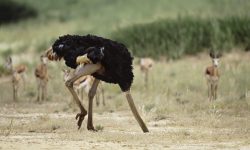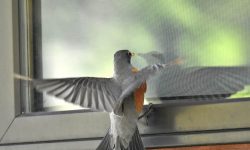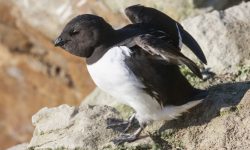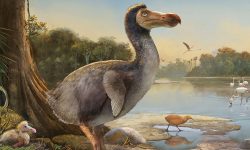The Aquatic Warbler (Acrocephalus paludicola) is more than just Europe’s rarest songbird—it is a living emblem of fragile wetland ecosystems under siege. Its lifecycle, played out in the hidden corners of sedge meadows and flood-prone fens, depends on a precise alignment of growth, habitat stability, predator evasion, and climatic balance.
From its vulnerable beginnings as a blind, featherless hatchling to its transformation into a long-distance migrant, each stage of its life reflects the intricate dependencies between species and landscape. Studying this journey does more than inform us about a single bird—it provides a blueprint for how to protect disappearing habitats, design targeted conservation strategies, and restore ecological resilience in some of Europe’s most endangered ecosystems.
In saving the Aquatic Warbler, we do not just rescue a bird—we preserve a living thread in the fabric of European biodiversity.

The Full Life Cycle of the Aquatic Warbler
The life of the Aquatic Warbler is a race against time, shaped by the demands of seasonal wetlands and long-distance migration. In just a few months, it must hatch, grow, mature, and prepare for a transcontinental journey—each stage marked by specific challenges and adaptations.
Nestling Stage: Rapid Growth in a Fragile Habitat
Aquatic Warbler chicks emerge blind, featherless, and entirely reliant on maternal care. The female provides both warmth and near-constant feedings of soft-bodied insects to fuel their intense metabolic needs. Nesting just 5–15 centimeters above saturated ground, these young birds grow rapidly—developing pinfeathers, opening their eyes, and beginning to regulate body temperature within the first week.
Yet this accelerated development unfolds in a perilous setting. Even a short burst of rain can flood the nest, while cool, damp nights increase the risk of hypothermia. Low vegetation offers little protection from predators like crows, stoats, or mustelids. In this stage, survival depends not just on parental effort, but on a narrow window of favorable weather, stable water levels, and dense vegetation cover.
Fledgling Phase: Learning Mobility and Survival
At just 10–12 days old, Aquatic Warbler chicks leave the nest before they can truly fly. This fledgling phase is marked by clumsy movement through the wetland vegetation as they begin to develop balance, coordination, and predator awareness. Although still partially dependent on the mother for occasional feedings, fledglings start to explore their surroundings and experiment with self-feeding. Their mobility remains limited, making them especially vulnerable to ground predators and exposure. Dense, layered vegetation is essential at this stage, offering the only protection from predators and the elements.
Juvenile Stage: Independence and Energy Storage
By late summer, fledglings transition into fully independent juveniles. They sharpen their foraging efficiency and begin accumulating energy reserves in the form of body fat—a physiological necessity for the long-distance migration ahead. Insect-rich wetlands are critical at this point; even slight habitat degradation or drought can reduce prey availability and interrupt fat storage. Juveniles that fail to reach a minimum energy threshold may not survive the journey south, making this a decisive period for long-term survival.
Adulthood and Migration: From Europe to Africa
As adults, Aquatic Warblers undertake a remarkable migration from Eastern Europe to sub-Saharan Africa. This transcontinental journey requires endurance, navigational precision, and careful alignment with seasonal food availability. Along the way, they depend on a network of wetland stopover sites to refuel and rest. Disruption to even one of these sites—through drainage, pollution, or human encroachment—can jeopardize the entire migration. Remarkably, many individuals show strong site fidelity, returning year after year to the same breeding meadows and staging grounds. This consistency highlights the importance of protecting habitat not just locally, but across their entire migratory range.
Nestling Phase: Fragile Beginnings in a Wetland Cradle
The life of an Aquatic Warbler begins in a state of extreme vulnerability. After a 10–12 day incubation period, hatchlings emerge as altricial young—entirely blind, featherless, and incapable of generating their own body heat. In this early stage, thermoregulation is absent, leaving chicks fully dependent on the warmth and care of the attending female. Their digestive systems are not yet mature enough for hard prey, so the mother supplies easily digestible, soft-bodied insects to support rapid tissue growth and metabolic demand.
By day three or four, pinfeathers begin to break through the skin, initiating the slow process of insulation and eventual flight feather development. Neurologically, chicks start to show increased responsiveness to sound and motion, which marks the onset of sensory development—crucial for later stages like fledging and self-feeding. Yet, this physiological progress unfolds within one of the most dangerous habitats a chick could inhabit.
Aquatic Warbler nests are built low—just 5 to 15 centimeters above the saturated ground—woven into clumps of sedges and grasses. While this position offers some camouflage in dense vegetation, it leaves the brood highly susceptible to flooding. A brief summer downpour or a minor rise in groundwater can submerge the nest within hours, resulting in the total loss of the clutch.
Compounding the hydrological risks is predation. Unlike forest songbirds whose nests are often hidden in foliage or tree cavities, Aquatic Warbler nests lie fully exposed from above and below. Corvids, such as crows and magpies, are adept at spotting open nests from the air. Meanwhile, mustelids (like weasels) and other small carnivores navigate the dense, wet undergrowth, actively seeking vulnerable prey. The combination of low elevation, open placement, and minimal structural protection makes this phase one of extremely high mortality.
Many broods perish before the nestlings can even open their eyes. Those that survive do so not by strength or defense, but through sheer luck of timing—being born into a window of stable weather, adequate insect supply, and minimal predator activity. For the Aquatic Warbler, the nestling stage is a crucible: a brief but perilous threshold that only the most fortunate cross into the next stage of life.
Fledgling Phase: Exposure Without Experience
Around 10 to 12 days old, Aquatic Warbler chicks leave the nest, entering the fledgling stage with limited flight ability and high vulnerability. Their movements are clumsy and conspicuous, and while they begin to forage on their own, they still depend on the female for supplemental feeding. Unable to escape effectively, they face constant risk from both aerial and ground predators.
Habitat structure is critical. Dense, tall sedges offer vital concealment during this stage, while degraded or mown areas expose fledglings to near-certain predation or weather stress. Unfortunately, this period often overlaps with early summer reed-cutting and mowing. Even slight mistiming can strip fledglings of their only cover before they can fly, resulting in high mortality.
This stage is a fragile window where the success of fledging hinges not only on natural development, but on human timing and habitat integrity.
Juvenile Phase: Building Independence and Fat Reserves
Roughly two to three weeks after leaving the nest, young warblers enter the juvenile phase. By now, they can sustain flight and forage for themselves, though their diet still mirrors that of adults—primarily consisting of insects like beetles, spiders, and flies caught from reed stems or water surfaces. The juvenile period is not only about mobility and self-feeding but also about preparing for a life-altering journey.
In late summer, juveniles must accumulate significant fat reserves to survive their migration to sub-Saharan Africa. This journey, covering more than 5,000 kilometers, requires extreme physiological endurance. Many juveniles do not survive this transition. Starvation, exhaustion, or failure to find suitable stopover sites during migration are common causes of mortality, particularly as climate variability disrupts insect availability and wetland consistency across the route.
Challenges to Survival: The Invisible Gauntlet
For the Aquatic Warbler, survival is not guaranteed by instinct alone. Although its life cycle is biologically hardwired—from hatching to migration—success at each stage depends entirely on external forces. The bird’s journey unfolds within a shifting landscape shaped by weather, water, and human intervention.
Flooded nests, degraded vegetation, food shortages, and sudden habitat loss are all silent killers. A brood may develop perfectly, only to drown in a single night of heavy rain. A fledgling may be healthy and alert, yet fall victim after nearby reeds are cut. In this invisible gauntlet, death rarely comes from weakness—it comes from timing misaligned with the environment.
What makes this fragility so urgent is that it scales beyond individuals. When conditions align poorly across a single season—delayed insect hatches, early mowing, or prolonged drought—the ripple effects can suppress reproduction across entire populations. Since Aquatic Warblers breed only once per year, a single failed season can set back regional recovery for years.
In this sense, the Aquatic Warbler becomes more than a bird—it is a barometer of wetland health. Its struggle reflects the tension between nature’s rhythms and human agendas. And as its numbers rise or fall, so too does our understanding of how fragile—and interconnected—these seasonal systems truly are.
Habitat Fragmentation and Drainage
The Aquatic Warbler’s fate is tightly bound to a disappearing landscape. It depends on wet sedge meadows and alkaline fens—habitats that have been drastically reduced by agricultural drainage, peat extraction, and land conversion. In regions like western Poland and Germany, once-extensive wetlands have been converted into farmland, stripping away the dense, moist vegetation needed for nesting and foraging.
This loss isn’t just about space—it changes everything. Drained soils alter local hydrology, causing vegetation to become sparse and insect populations to decline. Nests are left exposed to predators and vulnerable to dehydration or overheating. Even in places where wetlands are being restored, loss is still outpacing recovery, especially in key breeding zones.
Fragmentation worsens the crisis. As remaining habitats become scattered and isolated, gene flow between populations declines, making them more vulnerable to inbreeding, environmental stress, and reproductive failure. Small, disconnected groups are less resilient to sudden events like droughts or flooding, pushing already fragile populations closer to collapse.
Predator Pressure and Nest Accessibility
The Aquatic Warbler’s nesting strategy—building low, hidden nests within reeds—offers concealment, but comes with a serious trade-off: extreme vulnerability to predators. Unlike tree-nesting birds that gain height as a form of defense, Aquatic Warblers are exposed to both aerial and ground-based threats. Crows, magpies, stoats, and even free-roaming domestic cats can easily locate and destroy entire broods in seconds.
Because adult birds cannot physically defend their nests, their survival strategy hinges on stealth and placement. They feed chicks quickly and quietly, minimizing visits that might reveal the nest’s location. However, this strategy is only effective when vegetation is dense and layered.
Problems escalate when habitat is fragmented or overmanaged. Mowing, trampling, or the loss of low-intensity grazing practices can create open, uniform landscapes. These changes strip away visual cover, making nests easier for predators to detect. Even minor shifts in vegetation structure—such as a reduction in grass height or patch diversity—can drastically increase predation rates.
In this fragile balance, camouflage is currency, and the loss of microhabitat complexity can mean the difference between survival and failure.
Climate Instability and Hydrological Extremes
The Aquatic Warbler lives on a knife-edge of moisture balance. Its breeding success depends on fens and wet meadows staying consistently damp—but not flooded. A single summer downpour can inundate nests, especially in peatland habitats where water drains slowly. On the other hand, extended drought dries out soils, killing off insect prey and exposing eggs to overheating and desiccation.
Climate change is intensifying these extremes. In both Eastern Europe and the Sahel, weather patterns are becoming more erratic, with heavier rains, longer dry spells, and abrupt temperature shifts. These changes don’t just lower breeding success—they disrupt phenology, causing mistimed nesting, food scarcity during chick-rearing, and misaligned migration schedules.
For a species with just one breeding attempt per year, even a single misplaced season can have multi-year population consequences.
Anthropogenic Disturbance and Timing Conflicts
Even low-impact human activities can jeopardize Aquatic Warbler reproduction. Recreational visits, trail building, or overzealous birdwatching near nests can increase stress and lead to abandonment, especially in early incubation. Meanwhile, agricultural operations—such as early mowing or mechanical reed harvesting—often destroy nests outright or degrade breeding habitat before chicks can fledge.
The issue is not always the activity itself, but its timing. When conducted during peak nesting periods, otherwise routine land use becomes deadly. In response, conservationists in countries like Poland and Belarus have partnered with farmers to delay mowing until fledging is complete. These timing-based interventions have proven remarkably effective, in some cases doubling or tripling fledgling survival rates in core habitat zones.
Conservation Implications: A Race Against Time
Though the Aquatic Warbler faces mounting threats, conservation momentum is building. International collaborations, supported by the European Union and NGOs, are tackling the crisis through habitat restoration, scientific monitoring, and community outreach.
On the ground, projects are restoring critical wetlands by blocking drainage ditches, rewetting peat soils, and reintroducing light grazing to maintain habitat structure. These actions not only improve breeding conditions for Aquatic Warblers but also revive entire wetland ecosystems—supporting amphibians, rare plants, and invertebrates.
Meanwhile, advances in tracking technologies—including geolocators and satellite telemetry—have revolutionized conservation planning. By mapping juvenile dispersal and identifying mortality hotspots along migration routes, researchers can now target protections beyond breeding grounds, including stopover wetlands and African wintering sites.
Equally vital is public engagement. Conservation succeeds when local communities are part of the solution. Education programs and eco-tourism initiatives foster stewardship, making habitat protection a shared value rather than a top-down directive. Saving the Aquatic Warbler is no longer just about rescuing a bird—it’s about preserving wetland heritage for future generations.
Conclusion: The Narrow Window of Survival
The Aquatic Warbler’s journey from hatchling to adult is a miracle of biological timing and ecological harmony. Every stage of development is finely tuned to the rhythms of wetland life—but these rhythms are increasingly disrupted by human influence and climate volatility. Nestlings face drowning or predation before they even fledge. Fledglings must survive in fragmented, predator-rich landscapes. Juveniles must build strength and energy for a treacherous journey thousands of kilometers long.
Yet amid these odds, Aquatic Warblers continue to return each year, a testament to their resilience. Their survival, however, is no longer guaranteed by nature alone. It requires targeted, science-based conservation, local engagement, and a broader commitment to restoring the wetlands they—and countless other species—depend on.






